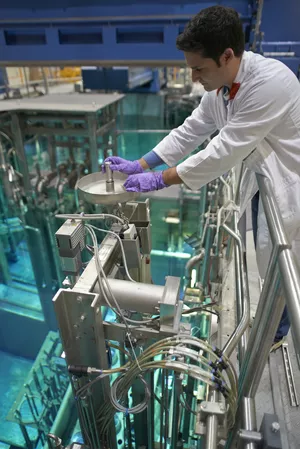Capsule Irradiation System

The capsule irradiation system (KBA) of the FRM II allows somewhat larger samples at high dose rates to be irradiated for periods spanning several hours up to weeks. It is a pool water-operated hydraulic rabbit system.
The samples are usually packed in waterproof welded aluminum tubes, which are in turn placed in water-permeable aluminum capsules with an internal volume of about 30 cm3, to allow for proper cooling of the samples during irradiation.
The KBA has two identical irradiation channels, which are able to convey up to three capsules simultaneously. A maximum of six capsules may be irradiated with a thermal neutron flux density of up to 1.3 x 1014 cm-2 s-1 (see table).
All transfers to and from the irradiation position are achieved via a carousel with 40 positions, which is located in the spent fuel pool. It remains permanently in 3.50 m deep water, which secures the shielding.
Industrial partners have radioisotopes irradiated at the capsule irradiation system of the FRM II, which are used, for example, in the treatment of tumours. The company ITM Isotope Technologies Munich SE on the campus in Garching, for instance, produces radioactive Lutetium-177 n.c.a. (n.c.a. – non carrier added), which helps to treat neuroendocrine tumours in patients all over Germany.